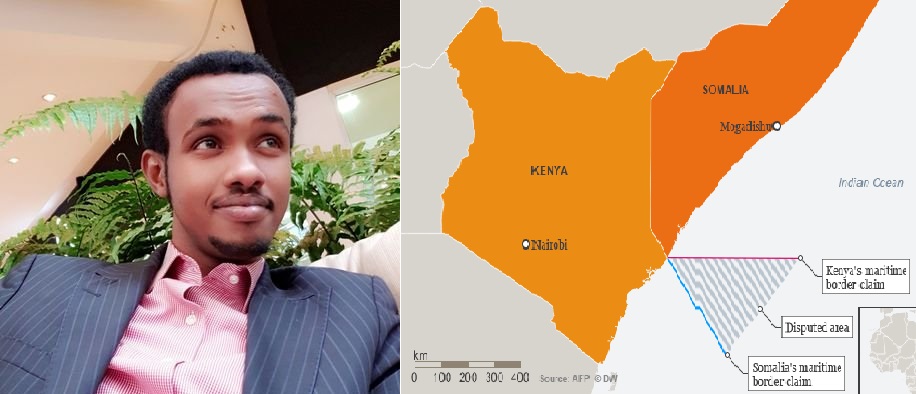The Kenya-Somalia maritime territorial dispute was a chain reaction of well-planned events by the Government of Kenya (GOK) that today cascaded to call of arms against the Federal Government of Somalia (FGS) and that “the use of military force should top the decision matrix.”
Let us follow these events chronologically.
Background
In the early 2000s, High ranking Kenyan officials obtained a geophysical and seismic data conducted by a Norwegian oil firm in 1987. The data showed that the maritime border between Kenya and Somalia has specific blocks whose oil and gas potential could change world energy prices.
In 2005, the Government of Kenya sent delegations to Baidoa to have a discussion on the matter with former Somalia President Abdullahi Yusuf Ahmed after the maritime boundary was revised for greater accuracy in a Second Presidential Proclamation. President Abdullahi Yusuf then citing national security and sovereignty concerns refused to engage with them on that matter.
The matter burst into the public domain on 10 March 2009, when Kenya then noted that it had extended its claim beyond the 200 nautical miles and had annexed 116,000 KM² in its submission before the United Nations Commission on the Limits of Continental Shelf (CLCS) conducted in 2009.
The key figure that assisted Kenya in that process was a senior Norwegian diplomat Mr Herald Brekke, Norway’s CLCS member at the time and Dr Karl Hinz a German expert and jurist.
February 2009, less than three months before the 13 May 2009 deadline for the submission of preliminary information to the CLCS, was one of the first tasks that demanded the new Somali government’s attention. The new TFG was unaware that the former SRSG to Somalia, Mr Ahmed Wallad Abdallah, had initiated preparation of Somalia’s preliminary information on Somalia’s behalf with Norway’s help. Norway came to the assistance of Somalia in preparing its submissions to the CLCS.
On April 7 2009, Kenya and Somalia signed MOU where they agreed that each of them will make separate submissions to the CLCS, that may include areas under dispute.
Minister Abdirahman Abdishakur was authorised to sign the MOU on Somalia’s behalf by means of a 7 April 2009 letter from then Prime Minister Omar Abdirashid Ali. In fact, Somalia had very little input on Kenya’s draft of the MOU. On his interview with Shabelle Radio on 12 April 2009, he said “Kenya is violating our territorial sovereignty with full impunity and we agreed to have our maritime boundry dispute settled before the CLCS or the ICJ.”
What does Kenya want?
Kenya wants the border to run along parallel latitude south-east of Kyunga, while Somalia is pressing for a diagonal line down the Kenyan Coast. Kenya was unable to come up with a compelling evidence of a historic title to the area or any other special circumstances. The most compelling argument that Kenya had brought before the ICJ and perhaps was the basis of its case was that Somalia violated the MOU agreement in 2009.
On the other hand, Somalia’s line of argument is consistent with Article 15 of UNCLOS. It’s argument is also based on the Somali marine law and Kenya marine law. Both laws were passed in 1972.
Kenya’s Hypocrisy & Hubris
Kenya auctioned the oil blocks under the disputed area on February 17, 2010. The oil blocks are L21, L22, L23 and L24. They were sold to the Stat Oil, ENI and TOTAL.
On 7 February 2019, Kenya falsely accused Somalia of selling oil licenses in the disputed area, something which they did themselves.
Meanwhile, all along while Somalia requested Kenya to re-open talks to demarcate maritime boundaries, Kenya declined Somalia’s invitation. Kenya was failing to turn up for talks, so they could gain enough time to withdraw their article 36 declaration which would block Somalia from bringing its case to the ICJ.
The tussle over the dispute began again in August 2014 when Somalia sued Kenya at the International Court of Justice (ICJ) for unlawful operations in her maritime territory and declared that “Somalia had exhausted all other avenues of finding an amicable solution to the dispute.”
In October 2015, Kenya challenged the jurisdiction of the ICJ to hear the case as well as its admissibility. The ICJ then held the first hearing on 19th and 20th of September 2016 on behalf of Kenya’s petition. In February 2017 it quashed Kenya’s plea, affirming its suitability to hear the case.
Subsequently, Somalia had written a letter dated 5th of March to all permanent missions to the UN in New York informing them that oral hearings by ICJ on the Somali-Kenya maritime dispute case will take place in September 2019, and judgement then made in 2020.
And now it all cascaded to call of arms against Somalia and that “the use of military force should top the decision matrix.”
Farah Mohamed Mohamed (Bukhaari) is a writer & political analyst passionate about politics and international affairs with keen interest in research and Horn politics. He can be reached at:
Twitter: Farah Mohamed Mohamed | https://twitter.com/Fbukhaari | Email: [email protected]


FAALLOOYIN & FALCELIN